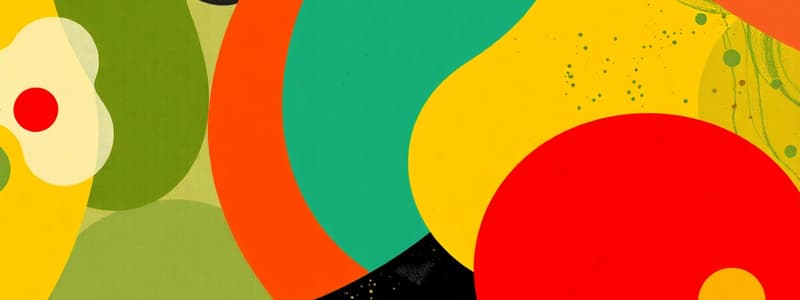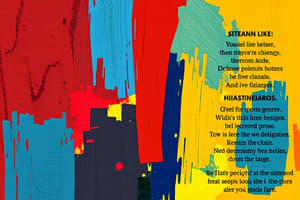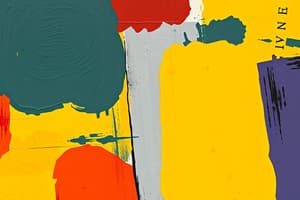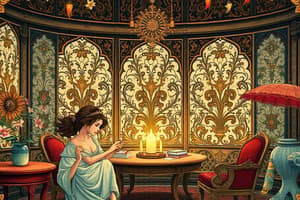Podcast
Questions and Answers
Which element is NOT typically associated with the genre of poetry?
Which element is NOT typically associated with the genre of poetry?
- Imaginative language
- Concentrated expression of ideas
- Rhythmical terms
- Realistic depiction of events (correct)
What is the primary difference between denotation and connotation?
What is the primary difference between denotation and connotation?
- Denotation is subjective, while connotation is objective.
- Denotation is the dictionary definition, while connotation is the implied meaning. (correct)
- Denotation is used in poetry, while connotation is used in prose.
- Denotation is the emotional association, while connotation is the literal definition.
Which of the following best describes the function of figurative language?
Which of the following best describes the function of figurative language?
- To provide historical context for the reader.
- To create a descriptive effect by conveying ideas that are not literally true. (correct)
- To ensure clarity and avoid any possible misinterpretation.
- To present information in a straightforward, literal manner.
What literary device involves a brief and indirect reference to a person, place, or event of historical, cultural, literary, or political significance?
What literary device involves a brief and indirect reference to a person, place, or event of historical, cultural, literary, or political significance?
Which rhetorical device presents two contrasting ideas in a parallel structure?
Which rhetorical device presents two contrasting ideas in a parallel structure?
What figure of speech involves directly addressing someone absent, dead, or inanimate?
What figure of speech involves directly addressing someone absent, dead, or inanimate?
What is the primary purpose of hyperbole in writing?
What is the primary purpose of hyperbole in writing?
In what way does situational irony differ from verbal irony?
In what way does situational irony differ from verbal irony?
Which figure of speech makes an implied comparison between two unrelated things?
Which figure of speech makes an implied comparison between two unrelated things?
What literary device uses words to imitate sounds?
What literary device uses words to imitate sounds?
Which figure of speech combines contradictory terms?
Which figure of speech combines contradictory terms?
What is a paradox in literature?
What is a paradox in literature?
What is the literary device where human qualities are attributed to non-human things?
What is the literary device where human qualities are attributed to non-human things?
Which figure of speech uses 'like' or 'as' to compare two different things?
Which figure of speech uses 'like' or 'as' to compare two different things?
What literary device uses a part to represent the whole, or vice versa?
What literary device uses a part to represent the whole, or vice versa?
What essay type objectively examines serious topics using an authoritative tone?
What essay type objectively examines serious topics using an authoritative tone?
An essay structured to present specific evidence leading to a broad conclusion uses which pattern?
An essay structured to present specific evidence leading to a broad conclusion uses which pattern?
Which element is essential to drama as a literary genre?
Which element is essential to drama as a literary genre?
What literary genre has an aesthetic appeal?
What literary genre has an aesthetic appeal?
What element of a plot introduces the setting, characters, and initial situation?
What element of a plot introduces the setting, characters, and initial situation?
Flashcards
Fiction
Fiction
A narrative prose showing an imaginative reconstruction of life that resembles the world.
Setting (Fiction)
Setting (Fiction)
The time and place in which the events in the story occur.
Characters (Fiction)
Characters (Fiction)
The representation of a human being in a story.
Characterization
Characterization
Signup and view all the flashcards
Poetry
Poetry
Signup and view all the flashcards
Denotation
Denotation
Signup and view all the flashcards
Connotation
Connotation
Signup and view all the flashcards
Imagery
Imagery
Signup and view all the flashcards
Figurative Language
Figurative Language
Signup and view all the flashcards
Allusion
Allusion
Signup and view all the flashcards
Antithesis
Antithesis
Signup and view all the flashcards
Apostrophe
Apostrophe
Signup and view all the flashcards
Hyperbole
Hyperbole
Signup and view all the flashcards
Irony
Irony
Signup and view all the flashcards
Verbal Irony
Verbal Irony
Signup and view all the flashcards
Situational Irony
Situational Irony
Signup and view all the flashcards
Metaphor
Metaphor
Signup and view all the flashcards
Onomatopoeia
Onomatopoeia
Signup and view all the flashcards
Oxymoron
Oxymoron
Signup and view all the flashcards
Paradox
Paradox
Signup and view all the flashcards
Study Notes
Literary Genres: Fiction
- Fiction is narrative prose, imaginatively recreating life but may be unrealistic.
- Elements of fiction include time and place (setting), and the representation of human beings (characters).
- Characterization is how writers reveal character personalities.
- Literary characters personalities are revealed by action, thoughts, descriptions, and authors descriptions.
Literary Genres: Poetry
- Poetry is the oldest literary form.
- Poetry is patterned, using concentrated, imaginative, rhythmical terms.
- Poetry often contains the elements of sense, sound, and structure.
Elements of poetry include:
- Sense of the poem
- Denotation is the dictionary definition of a word.
- Connotation is the suggested or implied meaning beyond the dictionary definition.
- Imagery uses sensory details appealing to the five senses.
- Figurative language is used descriptively, conveying non-literal ideas.
- Figures of speech uses devices with non-literal word definitions.
- Allusion is a brief, indirect reference to a person, place, thing, or idea of historical, cultural, literary, or political significance.
- Apostrophe is a figure of speech where a speaker directly addresses someone absent, dead, or inanimate.
- Antithesis puts opposite ideas together for a contrasting effect, using parallel structures.
- Hyperbole exaggerates ideas for emphasis ("My grandmother is as old as the hills").
- Irony is a figure of speech where words are used in such a way that their intended meaning is different from the actual meaning of the words.
- Verbal irony involves saying the opposite of what is meant.
- Situational irony is when an event occurs that directly contradicts the expectations of the characters, the reader, or the audience.
- Metaphor implicitly compares unrelated things sharing common characteristics.
- Onomatopoeia is a word that imitates natural sounds to enhance description.
- Oxymoron joins two opposite ideas for effect.
- Paradox is a self-contradictory statement with a latent truth, used to provoke thought.
- Personification gives human traits to nonhuman objects.
- Simile compares different things, showing similarities using "like" or "as”.
- Synecdoche uses a part to represent the whole, or vice versa
Essay
- Essay comes from the French word "essai" meaning trial or test.
- It is a prose composition on a single topic from a limited viewpoint.
Essay Elements:
- Idea
- Motive
- Structure
- Evidence
- Explanation
- Coherence
- Implication
- Presence
Essay Types:
- Strict or impersonal essays deal with serious authoritative topics, scholarly and objective.
- Casual or familiar essays deal with light, ordinary subjects in a friendly, humorous tone.
- Inductive pattern presents specific points leading to a general principle or thesis.
- Deductive pattern develops ideas from a general hypothesis to specific proofs.
Literary Genres: Drama
- Drama is prose in dialogue and action.
- Drama is meant for performance with literature and theater aspects..
- Realism is an accurate, detailed, life-like description in a play.
- Non-realism is stylized or theatricalized with an artist's imagination.
- Tragedy brings the main character to ruin or great sorrow..
- Comedy brings laughter when the protagonist overcomes difficulties and achieves their goal.
- Melodrama is drawn from tragedy, overstated, action-focused, and brings laughter.
Literary Standards
- Literary standards possesses qualities distinct from other writings.
- Universality appeals to everyone regardless of culture, race, gender, and time.
- Artistry has aesthetic appeal, possessing a sense of beauty.
- Intellectual Value stimulates critical thinking, enriching abstract and reasoning processes.
- Suggestiveness evokes emotional power, defining symbolisms and implied meanings.
- Spiritual Value elevates the spirit and soul, inspiring through morals and lessons.
- Permanence endures across time, being both timely and timeless.
- Style presents unique perspectives on life, marked by memorable substances.
- Exposition is the introductory material that gives the setting, creates the tone, presents the characters, and presents other facts necessary to understanding the story.
- Foreshadowing indicates hints or clues to suggest what will happen.
- Inciting force event triggers the conflict.
- Conflict is the essence of fiction, driving the plot.
- Rising Action is a series of events that builds from the conflict.
- Crisis is when the conflict reaches the turning points.
- Climax is the result of the crisis and the high point of the story for the reader
- Falling action closes the story with events after the climax.
- Resolution (Denouement) explains the rounding out and concludes the action.
- Major characters are three-dimensional, dynamic with good and bad qualities that evolve.
- Minor characters are two-dimensional and static, with one or two qualities, lacking depth.
Point of View
-First person narrators reveal personal thoughts and feelings. -Third-person objective narrators report only what they see and hear. -Third-person limited narrators see into one character's mind. -Omniscient narrators can enter multiple minds.
Conflict
- Man versus Man is the conflict of one person against another.
- Man versus Nature the runs-in with natural forces which tests human limits.
- Man versus Society challenges societal customs and values.
- Man versus Self is an internal conflict testing a character's values.
Foreshadowing
- Foreshadowing is how the author hints or clues toward events in the story
-Frequently creates suspense by building questions to encourage the reader to continue
- It also adds believability by subtly preparing the reader for later events. -Irony is the contrast between expectation and reality.
Three Types of Irony:
-Verbal Irony is when the meaning contrasts to what is said
- Irony of Situation is when it refers to happening opposite of what intended
- Dramatic Irony is when the audience or reader knows more than the characters
Literary Elements
TONE - Author's implied attitude that reveals words and details MOOD - Climate of feeling in work that creates setting, objects, details, images, and word choice SYMBOLISM - Person, place, object suggesting multiple meanings beyond obvious. THEME - Main idea or literary work meaning that is may imply statement or opinion on topic IMAGERY - Langue that appeals to the senses by using descriptions related to people objects
Five Genres of Literature
- Poetry
- Drama
- Prose
- Non-Fiction
- Media
Other
- Poetry is the oldest literary form meant to remember and recite.
- Prose is any written text not poetry.
- Drama is text meant for performance.
- Non-fiction features actual people and events.
- Media is a newer category including movies, websites, and commercials.
- Oral literature is the oldest form, foundational to culture.
- Folklore/Folk Tales/Fables has a distinction between regular prose and folklore.
- Graphic Novels & Comic Books are forms of literature suitable for children. Cultural Model - Literature that aims to understand and relate to culture and its values. Language Model - Lliterature that promotes development of vocabulary and structure. Personal Growth - Literature that aims for helping individual pleasure and deep satisfaction
Literary Devices
- Technique used by writers for special effect.
- Figures of Speech/Sound Devices - devices w/words, phrases/sentences in non-literal definition.
- Allusion - brief reference to person, place, thing, idea of historical or literary significance.
- Antithesis - rhetorical device w/opposing ideas for contrasting effect.
- Apostrophe - speakers address someone not present or inanimate object
- Hyperbole - Figure of speech using extreme exaggeration.
- Types of Irony - verbal and situational.
- Metaphor – figure of speech comparing 2 things w/o using like/as.
- Onomatopoeia – words which sounds like what they describe.
- Oxymoron – figure of speech combines 2 contradictory terms.
- Paradox – Greek word paradoxon meaning contrary to expectations
- Personification – giving human qualities to non-human things.
- Simile – figure of speech that compares 2 things using like/as
- Synecdoche - Part of something is used to refer to the whole thing
ASEAN Literature
- ASEAN=Association of Southeast Asian Nations=Brunei, Cambodia, Indonesia, Laos, Malaysia, Myanmar, Philippines, Singapore, Thailand, Vietnam.
- It was established in 1967 (Indonesia, Philippines, Singapore, Thailand) to promote cooperate on economical, political, social levels and regional stability.
Philippine Literature
- Literal Approaches =Feminism/New Historicism/Formalism or New Criticism
- Feminism -Literary pieces deal with women characters that reject common gender norms dominated by masculinity.
Filipino Women -
- Beverly Wico Sy - (Bebang Sy): Injects humor to write essays of Filipina women experience in macho culture - works = "It’s A Men’s World"/"It’s Raining Mens" /"Nuno Sa Puso: Pag-Ibig"/"Nono Sa Puso: Relasyon". Paz Marquez - Benitez - published 1st modern short story in Philippines ("dead stars" published in 1925). Genoveva Edroza-Matute – taught Filipino for 50 yrs at PNU; wrote "Ang Kwento ni Mabuti"/"Sa Ilalim ng Araw na Pula". New Historicism - Interprets in socio-historical atmosphere cultural context. Formalism or New Criticism – Formulate information with piece details & focus on rhetorical/logical connections.
Studying That Suits You
Use AI to generate personalized quizzes and flashcards to suit your learning preferences.




